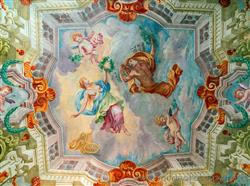|
Cavernago (Bergamo, Italy): Castle of Cavernago
|
|
|
Show an other place around Milan worth a visit: |
 In the fourteenth century instead of the castle there was probably a large landed estate rented to Guglielmo Assonica. In the fourteenth century instead of the castle there was probably a large landed estate rented to Guglielmo Assonica.
Later, in 1470, the estate was bought by the great military leader Bartolomeo Colleoni, about fourteen years after he had settled in the Castle of Malpaga.
Colleoni contributed to the restructuring of the latifundium and of the entire village of Cavernago, creating a small military complex. After his death the property was inherited in 1551 by Gherardo Martinengo, husband of the sister of Colleoni.
The Martinengo began the construction of the castle in 1597. The building was to function as a country house, but given the importance of the owner, it was built as a real fortress.
The presence of the Martinengo Colleoni was to last for over two hundred years through various historical and family events until, at the end of the nineteenth century, the branch of the family became extinct. After some property changes a period of total decadence and complete abandonment started after the last war. Since over sixty years it now belongs to the Princes Gonzaga of Vescovato, who are taking care of its meticulous restoration.
The building is a typical and precious example of a castle from the Baroque period. Its structure is in fact not that of a military fortress, built to counter and resist massive enemy attacks, since its main function was to provide protection only to those who lived there, constituting an important family residence.
The castle has a square plan and is surrounded by a deep and wide moat where now there is no more water (and perhaps there never was).
There was a wooden drawbridge that surpassed the large moat connecting with a masonry arch placed beyond the moat itself.
Subsequently the bridge was replaced by another masonry arch that connected perfectly with the existing one.
The entrance is formed by a round arch of considerable radius and fine workmanship.
In the entrance there are numerous signs that recall the old drawbridge.
On the main façade, the castle has the marble symbol of the Martinengo family: a large eagle surrounded by the Annunziata collar (Fig. 2).
Each façade has numerous windows due to the residential character of the complex.
At the sides of the castle there are four not very high towers slightly protruding from the rest of the structure.
These towers, due to the non-military character of the structure, do not have the typical battlements on the upper part, but loggias surrounded by arches supported by thin columns.
In the middle part of the south façade a low tower protruding from the walls has a stone bridge that goes beyond the moat.
This tower represents the second entrance, that overlooked the countryside.
The main entrance leads to a courtyard with the shape of an "U" that on the sides has arcade on both the ground floor and the upper floor.
The arcades have columns with Tuscan style capitals on the ground floor and columns with Ionic style capitals on the first floor.
The porticos on the ground floor have frescoed ceilings, as well as frescoes are in the lunettes above the doors and windows that open on the porticos.
In the case of the porticoes on the first floor to be frescoed are instead the spaces above the arches.
The large courtyard has a well in its wider part, now closed by a large grating.
The interior rooms are sumptuous and embellished with numerous frescoes and at the time contained a not indifferent wealth of furniture. Many ceilings are frescoed according to the trompe l'oeil technique, to simulate fake skies populated by mythological characters.
The castle is used partly as a private residence and partly as a location for events.
Categories: Places of historical value of artistic value
Via Castello di Cavernago, 1, 24050 Cavernago BG |
Further pictures of Castle of Cavernago in the section Photography |